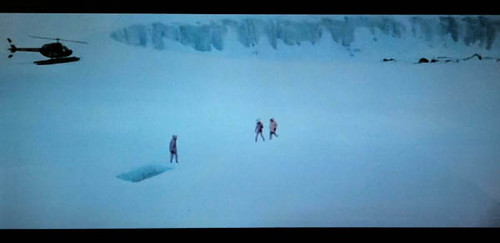Ice Patch Archaeology
 [Image: From The Thing, directed by John Carpenter].
[Image: From The Thing, directed by John Carpenter].As glaciers and mountain snow packs recede, their disappearance sometimes reveals archaeological evidence of earlier human settlements, with tools and other implements dropping out of the melting ice. As LiveScience reported back in April, "patches of ice that have been in place for thousands of years in the mountains of the Canadian High Arctic" are disappearing, revealing "a treasure trove of ancient hunting tools" in their wake.
The forensic investigation of these unexpected windows into human history has been dubbed "ice patch archaeology."
One of the field's originary archaeologists drew an analogy last week for how these artifacts probably got there:
- Maybe you missed a shot and your weapon disappeared into the snowbank. It's like finding your keys when you drop them in snow. You're not going to find them until spring. Well, the spring hasn't come until these things started melting for the first time, in some instances, in many, many thousands of years.
 [Image: Antarctica's Blood Falls", via Atlas Obscura].
[Image: Antarctica's Blood Falls", via Atlas Obscura].But we needn't turn to scifi to find extraordinary examples of "ice patch archaeology."
Earlier this year, for instance, Atlas Obscura noted a site in Antarctica called "Blood Falls." It is a "five-story, blood-red waterfall [that] pours very slowly out of the Taylor Glacier in Antarctica's McMurdo Dry Valleys."
- Roughly two million years ago, the Taylor Glacier sealed beneath it a small body of water which contained an ancient community of microbes. Trapped below a thick layer of ice, they have remained there ever since, isolated inside a natural time capsule. Evolving independently of the rest of the living world, these microbes exist in a world with no light or free oxygen and little heat, and are essentially the definition of "primordial ooze." The trapped lake has very high salinity and is rich in iron, which gives the waterfall its red color. A fissure in the glacier allows the subglacial lake to flow out, forming the falls without contaminating the ecosystem within.
Climate change, together with melting glaciers, becomes an inadvertent archaeology of the human—and profoundly inhuman—past.
But, of course, we've seen other stories like this, in which caches of human history unexpectedly reappear as the climate heats up. Last year, for instance, we looked at melting glaciers as chemical archives: "As the world's glaciers melt, they've begun to release an archive of banned industrial substances back into the environment, chemicals that have been locked, frozen, inside the glacial ice for up to thirty years."
Thirty years is nothing compared to the hundreds—often thousands—of years involved in ice patch archaeology, but the untimely release of dangerous chemicals we once thought long-forgotten is chilling proof that very few things are ever gone for good.
(Via Archaeology).





Comments are moderated.
If it's not spam, it will appear here shortly!
Since no one else has chipped in yet, it would be remiss of me to not mention this:
http://en.wikipedia.org/wiki/At_the_Mountains_of_Madness
It's probably too much to hope for any melting to reveal the remains of a million-year-old alien city.
John, indeed—I'm trying to think of Lovecraft's more explicitly archaeological stories, meanwhile (that is, stories involving archaeology as such, with literal excavation sites and so on), but I'm drawing a blank.
In any case, I owe you an email! Sorry about that—I will be in touch!
There's a couple of other stories which feature archaeology or something like it. Offhand, I can think of The Shadow Out of Time which has more alien ruins discovered in the Australian desert, and his early piece The Nameless City although the latter is more a case of accidental discovery as I recall. ATMOM is the most thorough since the city and its description is the centrepiece of the story.
No problem about the email, I've also been extremely busy this year.
Damn Interesting has a great article called 'Spies on the Roof of the World', which involves something very unpleasant ending up in a glacier in the Himalayas...
I also read about a plane that crashed into a glacier and was buried by heavy snowfall. It was estimated that it will emerge at the bottom in several thousand years.
Post a Comment